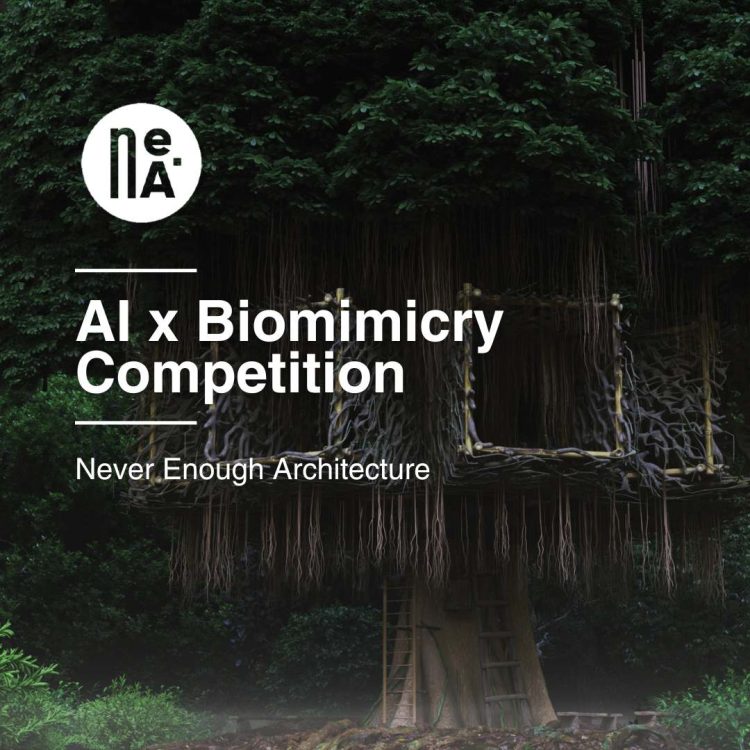Never Enough Architecture and the Antonio Gaudi Foundation Announces ‘Shatarupa’ as First Prize Winner in AI x Biomimicry Competition!
Never Enough Architecture, the world leader in promoting innovative and sustainable architectural practices, has partnered with the Antonio Gaudi Foundation to proudly announce the winners of the AI x Biomimicry Competition. This competition highlights the intersection of artificial intelligence and biomimicry in architecture, encouraging creative solutions for sustainable living.
First Prize: The first prize was awarded to Shubham Dalvi and Mrunmai Patil from India for their exceptional project ‘Shatarupa.’ Inspired by the living root bridges of Meghalaya and symbolizing “one with 100 forms,” their design integrates a bamboo framework with the Banyan tree’s natural growth. This living sculpture, evolving over time, serves as a shelter and harmonious space, uniting communities and tourists. The design emphasizes a symbiotic relationship with nature, allowing the structure to return to nature after serving its purpose, showcasing a zero-waste approach.
Second Prize: Wanchen Cai, Jiayan Huang, Siyu Dong, and Ruobing Cheng from China. Their project was recognized for its clear concept, good research, and understanding of biomimicry principles. The design, aimed at providing clean water in African deserts, was commended for its sensitive, practical approach to architecture and commitment to environmentally conscious design.
Third Prize: Giorgio Bonadei, Alessandro Agosti, Maurizio Nigro, and Francesca Girola from Italy. Their CILIA project was noted for its robust AI research and effective communication of operational mechanisms. The design was celebrated for its visionary integration of biomimetic principles for urban air purification.
This competition and the winning project embody Never Enough Architecture’s commitment to exploring the convergence of technology and nature in architecture. By highlighting such innovative designs, Never Enough Architecture continues to inspire and shape the future of sustainable and environmentally integrated architectural practices.
About Never Enough Architecture:
Dedicated to pushing the frontiers of architecture, Never Enough Architecture emphasizes the importance of sustainable and innovative design solutions. Through competitions and educational initiatives, it aims to inspire a new generation of architects to create structures that harmoniously coexist with their natural environments, using technology and creativity to address today’s environmental challenges. For more information, visit www.neverenougharchitecture.com
WINNERS
1ST PLACE
Shubham Dalvi, Mrunmai Patil
India

SHATARUPA
‘Shatarupa’ is a remarkable creation deeply rooted in the ancient Hindu scripture, where it signifies “one with 100 forms.” In this context, it symbolizes the multifaceted nature that has continually evolved, adapted, and improved itself through the ages. Our design follows the same theme, representing the countless forms and expressions of nature.
Inspired by the breathtaking innovation of nature living root bridges of Meghalaya, which are a testament to the indigenous Khasi tribes’ skill and the resilience of the Banyan tree (Ficus benghalensis). Over 15 to 30 years, these bridges have formed through the intricate process of inosculation, where Ficus aerial roots twine together over gorges and rivers, creating living works of art. ‘Shatarupa’ takes a leaf from Mother Nature’s book. In designing ‘Shatarupa,’ we’ve harnessed this very process.
We’ve introduced a framework of bamboo around the mighty Banyan tree, offering guidance to the roots as they grow. As this living sculpture evolves, it not only serves as a shelter to abode but also takes on the role of a harmonious mediator. It unites not just two living root bridges but also provides a tranquil space for local communities and curious tourists alike.
Beyond its aesthetic appeal, ‘Shatarupa’ assumes the role of a guardian, ensuring safe and easy travel between the two living root bridges. It offers a secure passageway while allowing all who cross it to immerse themselves in the natural beauty of Meghalaya.
This design aims to not impose on nature; rather, it allows nature to build upon the framework provided by humans, creating a space for both humanity and its own well-being.
We believe in returning to nature what we’ve borrowed. When ‘Shatarupa’ has served its purpose, we commit to returning it to nature’s embrace. While the design remains consistent, it minimizes waste on the human end, enabling nature to adapt and morph itself around the given framework using its own construction techniques. The very materials used in its construction will be reclaimed by the flora and fauna of Meghalaya, allowing the forest to reclaim its territory and seamlessly merge with the landscapes of Meghalaya once more.
Nature works in tandem with us, helping create the structure, allowing us to inhabit it, and eventually reclaiming it without any disruption. This design is a tribute to nature, acknowledging its supremacy and reconnecting us with our roots.
The concept originated from a tree serving as the foundational structure, evolving into a space where AI seamlessly integrated biomimicry. AI played a pivotal role, comprehending diverse forms and generating conceptual variations. It reimagined natural elements, contributing to a harmonious blend of biomimicry and AI-driven exploration. This collaboration transformed abstract ideas into a refined, innovative concept, synthesizing the organic essence of the tree with AI’s functional contributions. The result transcends conventional boundaries, showcasing a harmonious amalgamation of AI and biomimicry in architecture and nature-inspired design.
2ND PLACE
Wanchen Cai, Jiayan Huang, Siyu Dong, Ruobing Cheng
China

Fogcatcher
As the discernable climate change is unfolding on a planetary scale, we put our focus on the heart of the arid African desert, where water resource poses a significant challenge to local communities. “Fogcather” aims to use simple mechanisms and affordable local materials to capture clean and accessible water from the air.
Drawing inspiration from the cactus, we imagine a 20-meter spiraling tower for capturing water from foggy air. The core of the tower is constructed with rammed earth, and the rest is built using interlacing bamboo, both are common affordable construction materials in northern Africa. The core bamboo structure of the tower is wrapped by a web knitted with “cactus spines”. As stairs circular to each level, the web forms an inverted cone directing the captured water into the center of the tower to the underground tank. accessible from the ground level. The outer web that covers the whole tower maintains the moisture level around the tower, slows down the evaporation of water, and creates a greenhouse effect for direct agriculture around the tower.
During the process of design, once we have the general concept of the tower, we use Mid-journey to generate more renderings for inspiration. Beginning with the cactus’s form as a base, we later start to incorporate prompts with the cactus’s anatomy.
Catcus thrives in the desert by capturing water from fog. The hierarchical groove structure of their spine endows itself with a Laplace pressure gradient and wettability gradient, allowing water to flow even against gravity to the root of the spine. The scientists of Beihang University, Beijing have produced prototypes of artificial spines. In our scenario, we knitted the magnified spines as devices to a translucent fabric-made web.
The tower has platforms on each level and circular staircases. This is for community activity and access to maintenance. All the platforms face South receives the most sunlight, creating shades for each level below, on the north-facing side, the circulation of people and water happens in the shade. Individuals congregate beneath its shade, partaking in social gatherings, and growing crops for their essential needs. The spiral structure of the tower redirects the southwest wind of the desert to reduce wind load on the tower so that the structure can retain light, it also maximizes the area of the web.
Our design is constructed with consideration of sustainability, cost, maintenance, and the connection to the community. “Fogcather” is a beginning of a creative solution for local water resource management, nature’s brilliance has already presented us with countless possibilities for design.
3RD PLACE
Giorgio Bonadei, Alessandro Agosti, Maurizio Nigro, Francesca Girola
Italy

CILIA – Urban innovation project to clean city air
The project represents a bold urban innovation initiative designed to face one of the most critical problems of modern metropolises: air quality. The growing concern about air pollution, mainly caused by CO2 and heavy metals, prompted our team to conceive an innovative structure that would not only protect a dynamic public space but actively contribute to purifying the surrounding air.
BIOMIMETIC CONCEPT:
The bio-mimetic nature of the project takes its cue from the concept of cilia, the filter, and protection of such a fragile and fundamental element as the eye. The project incorporates ciliary architecture and translates it into an urban scale through vertical elements that screen out the sun’s rays and filter the air. In that case, the filtering apparatus consists entirely of “smog-eating” plants and shrubs.
Underground Floor: The Greenhouse
The underground level houses a greenhouse, with specific plants with remarkable “smog-eating” properties such as Viburnum, Arbutus, Photinia, Laurel, and Aleagnum.
These plants, together with a series of moss filters, can intercept heavy metals and break down atmospheric CO2, thus significantly improving air quality.
Ground Floor: Semi-covered square
The ground floor houses a first square, a multifunctional space designed to host cultural events, specific activities, or services for citizens. A series of vertical elements that play a crucial role in collecting polluted air surrounds the area. These convey air into the underground greenhouse to be purified.
First Floor: Open-air Square
The upper level offers an open square. Vertical pipes embrace the square and act as artificial “eyelashes” reacting to weather conditions. They are open to capturing polluted air like sails, providing an aesthetic and functional experience for users. In addition, these elements shade the square below, providing thermical and visual comfort. This dynamic filtering apparatus contributes to the purification process of the city air. The eyelashes have also been reinterpreted as street furniture at strategic positions in the city to distribute collected and purified air.
Project Aim
– Improve air quality in cities by contributing to the abatement of CO2 and heavy metals;
– Provide a multifunctional and accessible public space for citizens;
– Integrate architectural innovation and ecology;
– Design a new architectural model replicable at different scales;
– Generate a microclimate and filter fine dust;
– Landmark function for the urban landscape;
– Create an urban air quality sensor;
– Generate a system that enhances urban ecological culture.
SPECIAL HONORABLE MENTIONS
Milton Y. Tovar, Erika L. Chavarro, Julieth A. Colmenares, Celeste J. Romero
Colombia

Gabriela Piasta-Tworek
Poland









